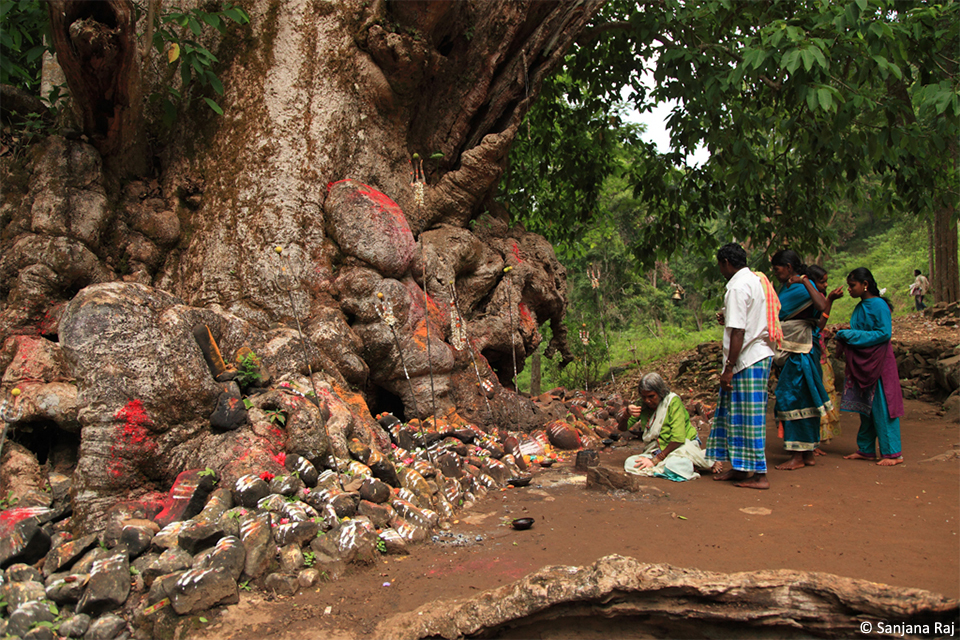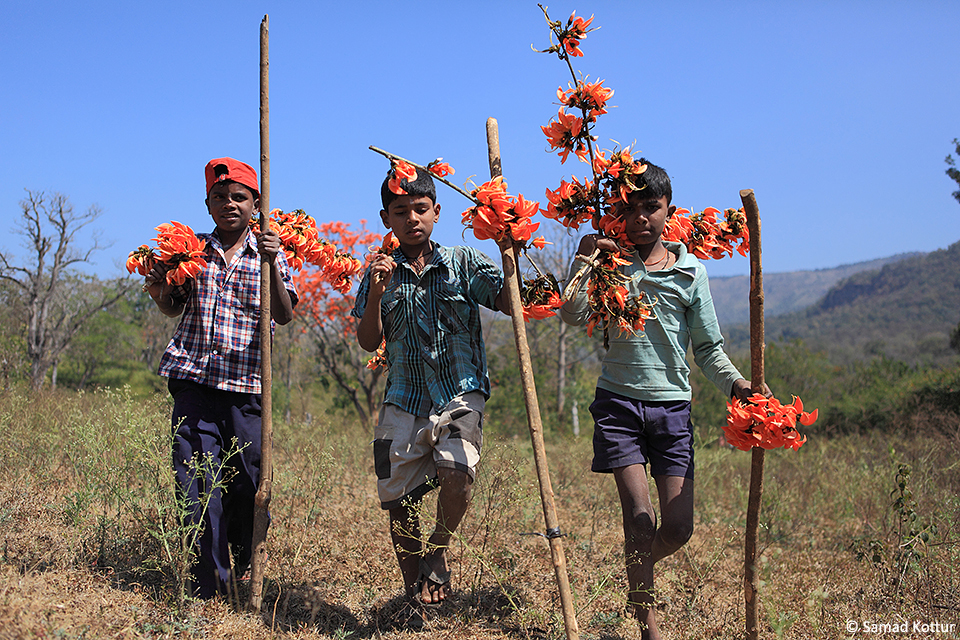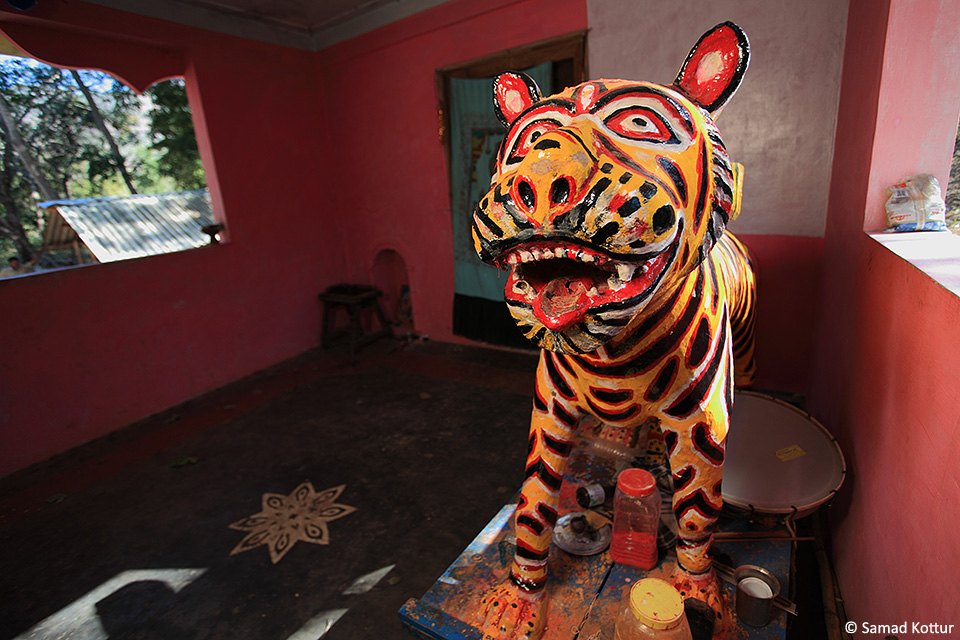Legend of Biligiri Ranganathaswamy Temple
One of the most prominent gods of BR Hills is Ranganathaswamy. The Tiger Reserve takes its name from the famous temple of Ranganatha, atop the Biligiri hill. A copper-plate record dated 1667 belonging to Mudduraju, son of Trimalarajanayaka of Hadinadu, sheds light on the history of the temple. Here, these hills are mentioned as that of Thiru Venkatanatha (reincarnation of Vishnu) of Bilikal (white rock). In Sanskrit, this hill was called Shwetadri, meaning white hill. This is because the hill’s weathered granite cliff-face appears white in colour. The Venkatanatha temple became known as Ranganatha temple after Tipu Sultan visited this temple while on a hunting expedition and described it as a temple of Lord Ranganatha. Hence, the name Biligiri Ranganathaswamy Temple.
The white cliff, which lends the name ‘Biligiri’ to the Ranganathaswamy temple on its peak.
Soliga lore recounts how Lord Vishnu, after slaying–an evil demon at some hills nearby, was looking for a place to finally rest. A local tribal god, Siddappaji, showed him this cliff. The story continues that the cliff emerged out from the forests around to make a good seat for the Lord. Further, the story says that the first Soliga, Bomme Gowda’s beautiful daughter Pusumale was wooed by none other than Lord Vishnu, cementing a bond between the Soliga people, their gods and the “mainstream” Hindu culture around. To this day, the temple of Biligiriranga, situated on the white cliff (Biligiri in Kannada), has strong links with the Soliga community. During its annual festival each March, the deity is carried by four Soliga youths.There is a mysterious tradition and legend about this temple. Anyone visiting the temple can see a huge pair of sandals. Legend has it that the presiding deity, Lord Ranganatha, used to roam around these forests using these sandals. Interestingly, these sandals wear out and are replaced regularly with new ones by the villagers.

The Lord’s footwear, which is worshipped and revered, surprisingly wears out, even when enclosed. This reinforces the belief that the Lord wanders around BR Hills.
The Doddasampige and Chikkasampige story
The Doddasampige (Michelia champaca) story traces back to sage Jamadagni, who lived with his wife Renuka and their seven sons, in the forest. Every day, Renuka would visit the nearby river-bed to make an earthen pot, in which she could carry water to her husband for his prayers. One day, she saw a celestial couple bathing playfully in the river and was longing to do the same with her husband. Soon she realized that it was a sin to have such thoughts, and she pushed it out of her mind. However, that day, no matter how much she tried, she was unable to brush these thoughts aside. Jamadagni used his yogic powers to know the truth. He decided to teach her a lesson for these sinful thoughts and asked his sons to cut off their mother’s head. All but the youngest refused, and in a fit of rage, were turned to ashes by their father.
Doddasampige, the soul of the tiger reserve, is centric to all gods of the Sholigas.

Stones adorn the base of this giant Champaca tree.
The youngest, Parashuram, followed his father’s wishes, and was granted three boons. First, he asked for his mother to be brought back to life. Second, he asked for his brothers to be brought back to life. As the third boon, he asked for his father’s anger to recede forever. All his wishes were fulfilled. But, Parashuram was disturbed by the fact that he had severed his mother’s head. He decided to leave home to observe penance for several months. On his way, a bird (Kraunchapakshi) defecated on his head, and Parashuram found three seeds in the bird’s excreta. He kept the seeds with him. One fell where he rested for a while, and gave rise to the Chikka Sampige tree (small champaka tree). When he finally sat down for his penance in the forest, another seed grew into the Dodda Sampige tree (big champaka tree). The third seedling was unaccounted for. Parashuram’s mother missed her son and turned into a river (the Bhargavi); she flowed down to where he was sitting, and can be seen even to this day.

Sholiga traditions and lore are passed on around campfires, through stories, even to this day.
Honnameti – The Golden Footprint
The original name of the stone is Metti Kallu – the circular stone. According to the Soligas, during the reign of Halaru-Cholaru, Honnu (Gold), Vajra (Diamond), Vaidurya (Platinum) used to be mined from the ground, with the help of the Metti Kallu. The Metti Kallu was used as a center stone, around which cattle were tied in a way that they would move in a circular fashion, thus mining the precious elements. All those precious elements were then stored in drums and buried under the ground. The ground was sealed from above, and the Metti Kallu was placed as a marker at that point.
The Honnameti stone, the Lord’s golden footprint.
Another story of the Honnameti mentions that Lord Ranganatha wandered around the hills and this spot is the place where the lord’s footprint took the form of a stone. Hence, it is called Honnameti – the golden footprint.
Story of Kyathadevara Gudi (K.gudi)
In the days of yore, the Gods (Devaru) fought demons. After the fight ended with good triumphing over the evil, two brothers, Hala Kethappa (elder brother) and Kunta Kethappa (younger brother), came to this area in search of a new, peaceful place. Hala Kethappa rode a majestic red horse, and they were accompanied by 700 soldiers (turuvadiru). After a long and tiring walk, Kunta Kethappa told his elder brother that he could not walk anymore and would stay at a place in the plains itself – at the temple known as Kuntagudi (which one can see this on the Hondarbal – K.gudi Road, before the climb). He also requested his brother not to leave him, to which the elder brother replied that he would go up the hills, but would keep a watch on the younger brother (the current alignment of the road is a testimony to this). He continued his journey up the hills. He left his soldiers (turuvadiru) at a place called Turuvanagadde and came to a flat area in middle of the hills, called K.Gudi now. Here, a stone is seen with the horse and the figure of Hala Kethappa on it, with a katti (sword) and a tupaki (gun-like weapon). The face of the stone is towards the direction of the Kuntagudi temple, where the younger brother had stayed back.

Kyathadevaragudi (K.gudi) is the backdrop for the staff of BRT Tiger Reserve. Religious places adorn the length and breadth of the tiger reserve and are a part of the daily lives of the Forest Department staff.
Lord Hala Kethappa was finally immortalized and resided along with Lord Mahadeshwara at his temple at Hedihallikodugalu. It was in form of a big stone with two different colours – the red part was Lord Kethappa, while the part with the stone’s original colour was Lord Mahadeshwara. Close to the temple was a settlement of Soligas near K.Gudi, at a place called Mogavare. A Soliga named Konnegowda had a dream, in which Hala Kethappa asked him to worship the stone weekly. Konnegowda build a grass shed over the stone and started worshipping it regularly.

Various forms of the tiger-riding Lord Mahadeshwara are worshipped; seen here is the Jadeswamy Temple sanctum.
Once, there was a natural fire in the forest, which reached the grass shed, and the temple at K.Gudi started burning. Lord Kethappa started calling Konnegowda from his palace, asking him to put out the fire at the temple. The voice of Lord Kethappa was so loud that Konnegowda could hear it at his podu (settlement). He came running to the temple and filled water in an earthen pot from a nearby pond. In a mad rush to douse the fire, he poured the water directly on the worshipped stone, which was quite hot by now because of the fire, and the stone cracked into pieces. Konnegowda was shocked by this and tried to put the pieces together. He put some random pieces together using mud, and on top of the heap, he placed the head of the original carving of Lord Kethappa.Legend has it that sometime later, Konnegowda went to harvest honey from beehives in Hedihallikodugalu and he slipped from a tall tree and died. It is said that the lord was unhappy with him over his mistake at the temple. Subsequently, after many years, the Maharaja of Mysore, Sri Jayachamarajedra Wadiyar, got the new temple built and the ritual of weekly worship continues by the local Soligas.

Tribal rituals range from the weird to the spiritual, include mortification as well.
Children carry ‘Flame of the forest’ (Butea monosperma) flowers for the festivities.
Kaati-Basava Temple
One the most recent temples built in the BR Hills is the Kaati-Basava temple on the Punjur-Bedaguli Road, with a very interesting story behind it. The BR Hills were the hunting grounds for the adventurous first family of coffee planters called the Morrises, in the early 1900s. One of the first colonisers was Randolph Morris. During a hunting expedition, he was gored by a Gaur and punctured his lung; he was given treatment and his life was saved. He went on to survive the attack and lived with only one lung for nine long years! After he passed away, his wife Mabel Morris constructed a temple in his memory, at the very spot where he was gored by a Gaur; she installed a stone carved like a Gaur, this came to be called the Kaati-Basava Temple. Subsequently, this stone carving has been supplemented with a new stone of Nandi – both the old and the new stone sit together, slightly away from the original site, by the side of the Punjur-Bedaguli Road.

The roadside Kaati Basava temple on the Punjur-Bedaguli road, a memorial temple erected by Mabel Morris, wife of Randolph Morris, at the spot where he was gored by a Gaur.
Legend has it that the gods of BR Hills preside and vent their anger on whoever harms the forest and wildlife. Interestingly, this legend was reinforced even in 2013, when a truck carrying harvested Silver Oak trees from coffee estates crashed downhill, right in front of the Kaati-Basava Temple.
A tiger idol sits in a temple. Interestingly, though revered and worshipped by Sholigas, it is called Doddanayi (big dog).
With modern pilgrimage tourism making inroads in a big way, it brings with it the problems of trash and feeding wild animals.
Despite an unflagging devotion to their work and to local gods, the frontline staff of the BRT Tiger Reserve risks the gauntlet of running into dangerous animals in their everyday life.
If at all there is any patch of forest in India which probably has the highest density of gods, with stories to match, topped by local folk tales, it must be BR Hills.




























Instagram
junglelodgesjlr